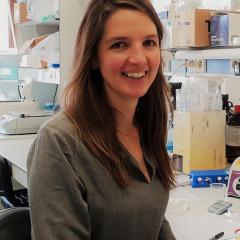Contagious - Results
Publications

Clinical practices underlie COVID-19 patient respiratory microbiome composition and its interactions with the host
Understanding the pathology of COVID-19 is a global research priority. Early evidence suggests that the respiratory microbiome may be playing a role in disease progression, yet current studies report contradictory results. Here, we examine potential confounders in COVID-19 respiratory microbiome studies by analyzing the upper (n = 58) and lower (n = 35) respiratory tract microbiome in well-phenotyped COVID-19 patients and controls combining microbiome sequencing, viral load determination, and immunoprofiling. We find that time in the intensive care unit and type of oxygen support, as well as associated treatments such as antibiotic usage, explain the most variation within the upper respiratory tract microbiome, while SARS-CoV-2 viral load has a reduced impact. Specifically, mechanical ventilation is linked to altered community structure and significant shifts in oral taxa previously associated with COVID-19. Single-cell transcriptomics of the lower respiratory tract of COVID-19 patients identifies specific oral bacteria in physical association with proinflammatory immune cells, which show higher levels of inflammatory markers. Overall, our findings suggest confounders are driving contradictory results in current COVID-19 microbiome studies and careful attention needs to be paid to ICU stay and type of oxygen support, as bacteria favored in these conditions may contribute to the inflammatory phenotypes observed in severe COVID-19 patients.

Increased IL-10-producing regulatory T cells are characteristic of severe cases of COVID-19
The pandemic spread of the coronavirus SARS-CoV-2 is due, in part, to the immunological properties of the host–virus interaction. The clinical presentation varies from individual to individual, with asymptomatic carriers, mild-to-moderate-presenting patients and severely affected patients. Variation in immune response to SARS-CoV-2 may underlie this clinical variation.

Monocyte-driven atypical cytokine storm and aberrant neutrophil activation as key mediators of COVID-19 disease severity
Epidemiological and clinical reports indicate that SARS-CoV-2 virulence hinges upon the triggering of an aberrant host immune response, more so than on direct virus-induced cellular damage. To elucidate the immunopathology underlying COVID-19 severity, we perform cytokine and multiplex immune profiling in COVID-19 patients. We show that hypercytokinemia in COVID-19 differs from the interferon-gamma-driven cytokine storm in macrophage activation syndrome, and is more pronounced in critical versus mild-moderate COVID-19. Systems modelling of cytokine levels paired with deep-immune profiling shows that classical monocytes drive this hyper-inflammatory phenotype and that a reduction in T-lymphocytes correlates with disease severity, with CD8+ cells being disproportionately affected. Antigen presenting machinery expression is also reduced in critical disease. Furthermore, we report that neutrophils contribute to disease severity and local tissue damage by amplification of hypercytokinemia and the formation of neutrophil extracellular traps. Together our findings suggest a myeloid-driven immunopathology, in which hyperactivated neutrophils and an ineffective adaptive immune system act as mediators of COVID-19 disease severity.

Genome-wide CRISPR screening identifies TMEM106B as a proviral host factor for SARS-CoV-2
The ongoing COVID-19 pandemic has caused a global economic and health crisis. To identify host factors essential for coronavirus infection, we performed genome-wide functional genetic screens with severe acute respiratory syndrome coronavirus 2 (SARS-CoV-2) and human coronavirus 229E. These screens uncovered virus-specific as well as shared host factors, including TMEM41B and PI3K type 3. We discovered that SARS-CoV-2 requires the lysosomal protein TMEM106B to infect human cell lines and primary lung cells. TMEM106B overexpression enhanced SARS-CoV-2 infection as well as pseudovirus infection, suggesting a role in viral entry. Furthermore, single-cell RNA-sequencing of airway cells from patients with COVID-19 demonstrated that TMEM106B expression correlates with SARS-CoV-2 infection. The present study uncovered a collection of coronavirus host factors that may be exploited to develop drugs against SARS-CoV-2 infection or future zoonotic coronavirus outbreaks.

Establishing a Unified COVID-19 "Immunome": Integrating Coronavirus Pathogenesis and Host Immunopathology
A unified COVID-19 “immunome” model integrating lung-associated pathophysiology with systemic immunopathology, together accounting for the SARS-CoV-2/COVID19 immunological paradigm. SARS-CoV-2 exhibits increased (direct) tropism toward ACE2+ epithelial cells within the lungs and upper-airways that, due to viral replication, ultimately results in epithelial cell death and epithelium disruption. This is paralleled by disruption of type I interferon (IFN) responses within infected cells, possibly due to direct interference by SARS-CoV-2 derived anti-IFN modules. This is accompanied by release of damage-associated molecular patterns (DAMPs; coming from dying/dead epithelial cells) as well as pathogen-associated molecular patterns (PAMPs; coming from viral genetic material and immunogenic proteins). These events, together with the above viral pathogenic events, fuel dysregulated myeloid hyperinflammation. In addition, through as-yet-unclear mechanisms, SARS-CoV-2 may also exert direct or indirect cytopathic effects on myeloid immune cells, thereby further facilitating immune dysregulation. These events together characterize the COVID-19-associated ARDS phenotype. This ARDS can: (I) on one hand, facilitate systemic cytokine-driven hyperinflammation; yet (II) on the other hand, stress the lymphoid organs by demanding increased recruitment of immune cells for resolution of inflammation. Such prolonged immunological stress accompanied by cytokine-based inflammation facilitates lymphopenia, typically observed in COVID-19 patients (and may also cause lymphoid organ failure if this stressful situation prolongs, as seen in some critically ill patients). Herein, there is some evidence that SARS-CoV-2 may exert (in)direct cytopathic effects against lymphocytes thereby further fuelling lymphopenia. Together these processes define the overall immunological phenotypes or inclusive phenome (i.e., “immunome”) of COVID-19.

Discriminating mild from critical COVID-19 by innate and adaptive immune single-cell profiling of bronchoalveolar lavages
How the innate and adaptive host immune system miscommunicate to worsen COVID-19 immunopathology has not been fully elucidated. Here, we perform single-cell deep-immune profiling of bronchoalveolar lavage (BAL) samples from 5 patients with mild and 26 with critical COVID-19 in comparison to BALs from non-COVID-19 pneumonia and normal lung. We use pseudotime inference to build T-cell and monocyte-to-macrophage trajectories and model gene expression changes along them. In mild COVID-19, CD8+ resident-memory (TRM) and CD4+ T-helper-17 (TH17) cells undergo active (presumably antigen-driven) expansion towards the end of the trajectory, and are characterized by good effector functions, while in critical COVID-19 they remain more naïve. Vice versa, CD4+ T-cells with T-helper-1 characteristics (TH1-like) and CD8+ T-cells expressing exhaustion markers (TEX-like) are enriched halfway their trajectories in mild COVID-19, where they also exhibit good effector functions, while in critical COVID-19 they show evidence of inflammation-associated stress at the end of their trajectories. Monocyte-to-macrophage trajectories show that chronic hyperinflammatory monocytes are enriched in critical COVID-19, while alveolar macrophages, otherwise characterized by anti-inflammatory and antigen-presenting characteristics, are depleted. In critical COVID-19, monocytes contribute to an ATP-purinergic signaling-inflammasome footprint that could enable COVID-19 associated fibrosis and worsen disease-severity. Finally, viral RNA-tracking reveals infected lung epithelial cells, and a significant proportion of neutrophils and macrophages that are involved in viral clearance.
